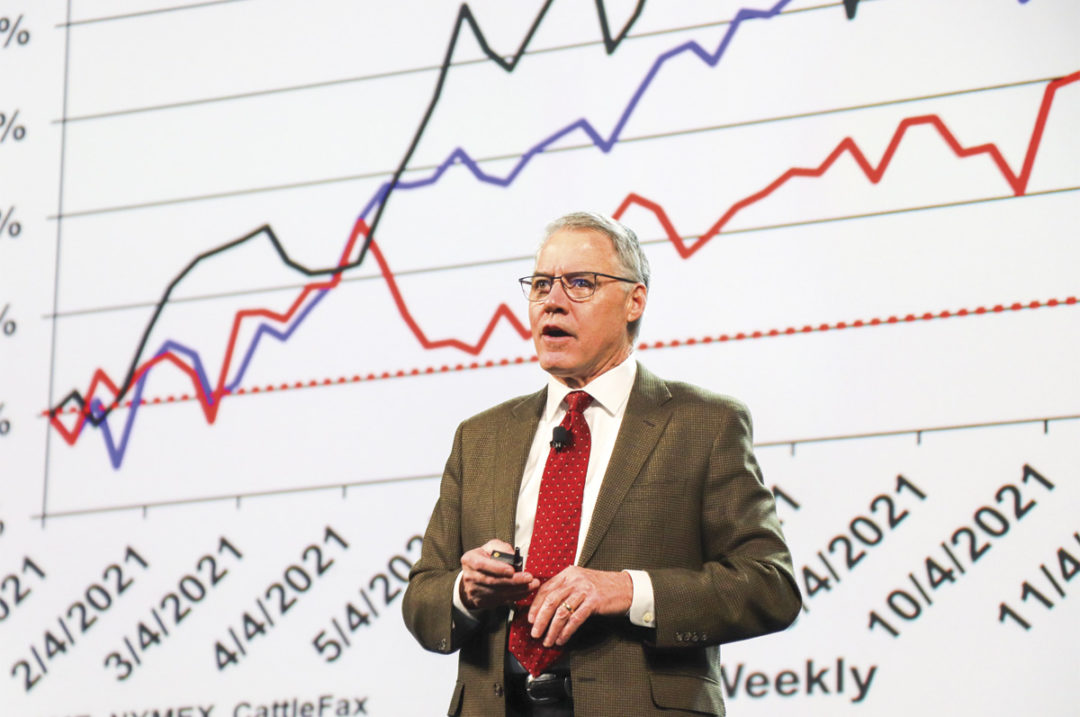Randy Blach, CEO of CattleFax, told ranchers attending the National Cattlemen’s Beef Association (NCBA) Cattle Industry Convention in Houston that value-added programs paying high premiums have boosted beef demand and spread wealth throughout the industry. “A handful [of] years ago, we're sitting here in this conference having this conversation and everybody was worrying, ‘Well if we keep making these cattle better, there won't be any premiums left.’ How far off was that assumption?”
The year 2021 showed a record for large wholesale grade premiums to $58. Choice to Select spread was $17 per hundredweight (cwt), Certified Angus Beef (CAB) to Choice spread was $19 and the CAB to Prime was $18. “Even though we've had this kind of the increase in supply, Prime went from 2 percent of our supply to 10 percent,” Blach said. “Record premiums – what's that tell you? That tells us our consumers are voting with their pocketbook[s] and they want more marbling. They want the good stuff. They love the taste of grain-fed beef, and they want that on a more-regular basis.”
Driven by those premiums and value-added programs, CattleFax forecasts show strong price growth for calves, feeder calves, fed cattle and bred cows in 2022. All four segments of the industry, cow-calf, stocker, feeder and packer, should see a combined profitability of $800 per head to be shared among them.
U.S. cattle slaughter continues to work through fed cattle backlogs brought on by COVID-19 disruptions and labor shortages, Blach told those at the convention. The level of currentness in the feeding sector is beginning to catch up to levels seen before the Tyson plant fire in fall 2019. That momentum portends a shift of price leverage back to cow-calf, stockers and feeders. Blach said that led directly to a price spike in fed cattle markets in late November to December as prices bounced from $124 per cwt up to $140.
“Remember, we've been running these plants harvesting nearly 50,000 cattle every Saturday for the last three years.” That volume of slaughter creates pressure on plants to have continuing staff during an ongoing pandemic. The crush is significant and explains market dynamics the past five years. Packer capacity contracted after cattle inventory numbers dropped beginning in 2009. By 2016, the expansion of cattle caught up to and surpassed the ability of packers to keep up. By the time of the Tyson fire shutdown and COVID-19 pandemic, logjams grew to hundreds of thousands of cattle through much of 2020 and 2021. “You can see where we're going; we're quickly going to see the capacity and the supply flip.”
Blach said that just by measure of the extra 50,000 head that are being processed on Saturdays – the numbers show a level of production that can support expansion. But packer expansion would be insulated with even more growth in fed cattle. “We’ve got to be thinking longer term, that we [have] to have more capacity. That’s a good assumption that we're going to be able to run these plants as hard on Saturdays when we look down the road over the next several years. Again, do the math with me. How many cattle on feed would we have to kill? How much more capacity? What would we need in a five-day week if we’re offsetting that 50,000 head on Saturdays? It’s really important you think that through.”
CattleFax’s $800 profitability margin per head is the second highest in the history of the industry, Blach said. “Again, I can't tell you whether the cow-calf producer will make 200 of that, and the feeders are making 100 and stockers are going to make 100 and packers are going to make 300. The market will sort all that out.”
Offering a warning on the price discovery debate, Blach said that value-added programs fuel $1 billion per year into the industry, and changes that create imbalance are a warning. Secondly, if price discovery leads to a contract library, the four major packing companies could still have an informational advantage above the thousands of feeders in the country.
“We are seeing the leverage shift; you're going to see less margin at the packer level, less margin at the retail level as we work through 2022 and on into 2023. You're going to see more of that margin shift back into producer markets.”









